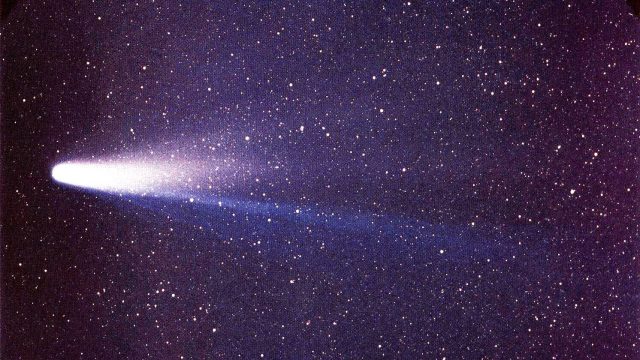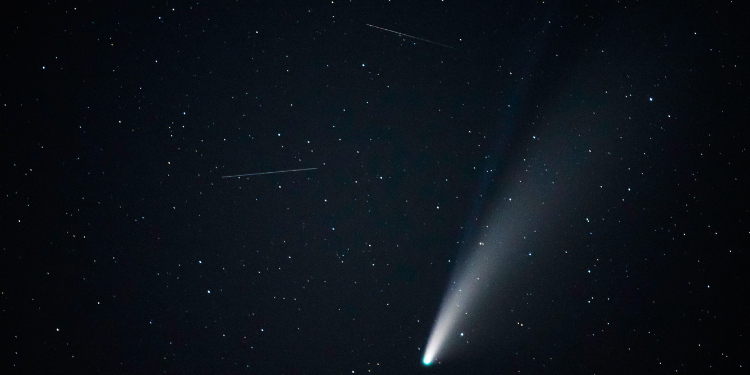This year skywatchers have a rare opportunity to glimpse a visitor from the distant reaches of our solar system: Comet 12P/Pons-Brooks. While comets grace our night skies somewhat regularly, 12P/Pons-Brooks offers a captivating spectacle due to its potential for sudden outbursts in brightness and its historical significance. This easy-to-understand guide delves into the comet’s fascinating story, how to spot it, and what we can expect during its current apparition.
Unveiling the Discoverers: A Tale of Two Comet Hunters
The comet bears the names of two renowned astronomers who made independent discoveries of the celestial object. First, we have Jean-Louis Pons (1761-1831), a French astronomer widely considered the greatest visual comet discoverer of all time. In today’s world, astronomers typically use powerful telescopes and robotic cameras to detect comets far beyond the range of human vision. However, Pons relied on his own ingenuity, crafting telescopes with large apertures and short focal lengths, perfect for spotting faint celestial objects. Remarkably, between 1801 and 1827, Pons visually discovered a record-breaking 37 comets!
One such discovery occurred on July 12, 1812, when Pons observed a “shapeless object with no apparent tail.” Over the following month, the comet brightened, becoming visible to the naked eye at its peak in mid-August. It boasted a remarkable split tail measuring approximately three degrees long. Initial orbital calculations suggested the comet had a periodic orbit, taking roughly 65 to 75 years to circle the sun.
Fast forward to September 1883, when British-born American comet observer William R. Brooks (1844-1921) independently spotted the same celestial body. Brooks, much like Pons, was a prolific comet discoverer, ranking second only to Pons with 27 visual discoveries. It wasn’t until orbital calculations were made on Brooks’ discovery that astronomers realized it was the same comet Pons had observed in 1812. Hence, the comet now carries the surnames of both observers, forever linked in astronomical history.

A Halley-Type Comet with a Storied Past
12P/Pons-Brooks is classified as a “Halley-type” comet, meaning its orbital period falls between 20 and 200 years. Comets of this type typically appear only once or twice within a human lifetime. Other notable Halley-type comets include 13P/Olbers, 23P/Brosen-Metcalf, and the most famous of all, 1P/Halley. The designation 12P/Pons-Brooks signifies that it was the twelfth comet to have a definitive orbital period calculated.
Historical records suggest 12P/Pons-Brooks may have graced our skies for millennia. Astronomers believe a bright comet observed by the Chinese in November 1385 and another sighted by an Italian astronomer in January 1457 were likely apparitions of 12P/Pons-Brooks. There’s even some evidence that an ancient record of a bright comet dating back to 245 A.D. might be referring to this very comet.
The comet’s appearance in 1883-1884 was particularly noteworthy. It made its closest approach to Earth on January 10, 1884, at a distance of 58.6 million miles (94.3 million km), just 16 days before reaching perihelion (its closest approach to the sun). During this time, the comet reached a brightness of third magnitude, visible to the naked eye, and displayed a stunning tail measuring an impressive 20 degrees in length. Sketches made by astronomers during this period captured the comet’s majestic presence.
Another interesting aspect of 12P/Pons-Brooks is its tendency for sudden outbursts in brightness. Observations in 1883-1884 revealed instances where the comet’s brightness would unexpectedly increase. This characteristic earned it the reputation of a “capricious comet.” This erratic behavior continued, with the comet experiencing four more outbursts on its way back towards the sun in 1954.
12P/Pons-Brooks Makes a Grand Return – What to Expect
This year, 12P/Pons-Brooks is back, reaching perihelion on April 21. True to form, the comet has already exhibited its characteristic flare-ups. In July 2023, an unexpected outburst caused the comet to briefly become 100 times.
Where and When to Find the Comet: A Viewing Guide
If you’re eager to catch a glimpse of 12P/Pons-Brooks, here’s what you need to know:
Visibility: From now until the end of March, the comet will be visible in the early evening sky within the constellation of Andromeda. Look for it hovering about 20 degrees above the west-northwest horizon at the end of evening twilight. A good star chart will be helpful in locating Andromeda.
Equipment: With a dark sky and the aid of binoculars, you should be able to spot the comet. By mid-March, it will likely be a 6th-magnitude object, readily visible in binoculars.
Peak Visibility: The best time for naked-eye viewing is expected to be around the end of March, when the comet passes very close to the 2nd-magnitude star Hamal in the constellation Aries. By this point, the comet may reach 5th magnitude and potentially sport a short tail.
Later Visibility: Afterward, the comet will disappear into the sunset glow during April as it approaches perihelion. Unfortunately, it won’t be readily visible from the Northern Hemisphere after that point and will become an object primarily for Southern Hemisphere observers.
Future Flares and the Solar Eclipse: A Realistic Look
There has been some speculation about the possibility of another significant flare-up making the comet a spectacular sight. Experts believe this is unlikely. The comet’s overall brightness has increased significantly as it has moved closer to the sun, meaning any future flare-ups would result in a smaller relative increase in brightness.
The possibility of seeing the comet during the total solar eclipse on April 8th is also considered highly improbable. Predictions suggest the comet won’t reach a brightness much higher than magnitude +4.5 around eclipse time, far too faint to be visible even with a potential flare.
A Once-in-a-Lifetime Opportunity (for Most)
For most skywatchers, this year’s apparition of 12P/Pons-Brooks represents a unique chance to witness this fascinating comet. If you miss it this time around, the next opportunity won’t come for another 71 years. Astronomers predict the comet’s next perihelion will occur in August of 2095.
Tips for Observing 12P/Pons-Brooks
- Find a dark location with minimal light pollution.
- Use a star chart to locate the comet’s position in the night sky.
- Binoculars are highly recommended for a better view.
- A telescope can offer an even more detailed look for experienced observers.
- Patience is key! Comets can be faint, so give your eyes time to adjust to the darkness.
- Check online resources for the latest updates on the comet’s position and brightness.
By following these tips and a little bit of luck, you might just be able to witness the captivating spectacle of Comet 12P/Pons-Brooks during its current visit to our celestial neighborhood. So grab your binoculars, head out under the dark sky, and take a moment to marvel at this celestial visitor from the distant reaches of our solar system.



















